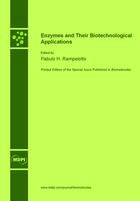Enzymes and Their Biotechnological Applications
A special issue of Biomolecules (ISSN 2218-273X).
Deadline for manuscript submissions: closed (30 June 2013) | Viewed by 281380
Special Issue Editor
Interests: microbiome; molecular microbiology; metagenomics; omics; biostatistics; next-generation sequencing; microbial ecology; bioinformatics; biotechnology; system biology; grand challenges
Special Issues, Collections and Topics in MDPI journals
Special Issue Information
Dear Colleagues,
The development of new enzymes is one of the most thriving branches of biotechnology. Although the applications of enzymes are already well established in some areas, recent advances in modern biotechnology have revolutionized the development of new enzymes. The use of genetic engineering has further improved manufacturing processes and enabled the commercialization of enzymes that could previously not be produced. Protein engineering and the possibility of introducing small changes to proteins are bringing ever more powerful means of analysis to the study of enzyme structure and its biochemical and biophysical properties, which have leading to the rational modification of enzymes to match specific requirements and also the design of new enzymes with novel properties. The developments in bioinformatics and the availability of sequence data have significantly increased the efficiency of identifying genes with biotech potential from nature. Complementary to chemical synthesis, biosynthesis of drug metabolites with mammalian or microbial bioreactors offers certain advantages, and sometime is the only practical route to the desired metabolite. At the same time, new technological developments are stimulating the chemical and pharmaceutical industry to embrace enzyme technology. Altogether, these advances have made it possible to provide tailor-made enzymes displaying new activities and adapted to new process conditions, enabling a further expansion of their use in several branches of biotechnology. This Special Issue focuses on the discovery and development of new enzymes and their applications in different areas of biotechnology. The Special Issue will contain a collection of papers written by authors who are leading experts in the field including selected papers from the 4th International Symposium on Enzymes & Biocatalysis (SEB-2013). We cordially welcome you to join us in this endeavor. The submission of comprehensive reviews or original research articles is most welcome. It is an opportunity to take part in and to influence future trends in one of the fastest growing fields of research.
Professor Pabulo Henrique Rampelotto
Guest Editor
Manuscript Submission Information
Manuscripts should be submitted online at www.mdpi.com by registering and logging in to this website. Once you are registered, click here to go to the submission form. Manuscripts can be submitted until the deadline. All submissions that pass pre-check are peer-reviewed. Accepted papers will be published continuously in the journal (as soon as accepted) and will be listed together on the special issue website. Research articles, review articles as well as short communications are invited. For planned papers, a title and short abstract (about 100 words) can be sent to the Editorial Office for announcement on this website.
Submitted manuscripts should not have been published previously, nor be under consideration for publication elsewhere (except conference proceedings papers). All manuscripts are thoroughly refereed through a single-blind peer-review process. A guide for authors and other relevant information for submission of manuscripts is available on the Instructions for Authors page. Biomolecules is an international peer-reviewed open access monthly journal published by MDPI.
Please visit the Instructions for Authors page before submitting a manuscript. The Article Processing Charge (APC) for publication in this open access journal is 2700 CHF (Swiss Francs). Submitted papers should be well formatted and use good English. Authors may use MDPI's English editing service prior to publication or during author revisions.
Keywords
- biocatalysis polymerization and polymer synthesis
- biocatalysis synthesis of chiral molecules
- biocatalytic technologies
- enzyme biosensor
- enzyme inhibitors
- environmental enzymology
- enzymatic protein engineering technology
- extremophilic enzymes
- functional genomics and bioinformatics for novel enzymes
- industrial biotechnology
- new enzyme development
- pharmaceutical biotechnology
- structural and functional characterization of enzymes







